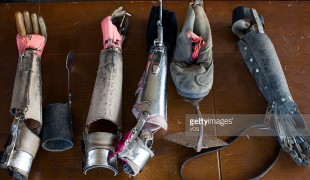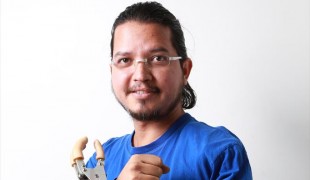- 4221
- 311
- 12
- 15
- 0
- Help Ukraine
About the solution
Mark refused to accept that there were no prosthetic arms for him. So he has driven him to travel the world testing various alternatives and helping himself while also adding to the body of knowledge in the specialty of prosthetic limb technology.
The inventor, who works in a mechanic shop, tired a cosmetic arm, but it was useless. Later he bought a $80,000 sophisticated arm, but it wasn’t good for his machine-shop work.
So Mark kept looking for solutions. He went to Sweden, where doctors screwed a bolt into the few centimeters of bone in his upper arm. This bone implant surgery was not, at the time, approved in the United States or Australia.
"The bolt gave me the shoulder function back," Mark explained. Using the bolt as a base allows him to point the arm and feel connected to it.
After the surgery, the mechanic heard about the Carnes Arm, an old, but sophisticated and mechanical prosthetic arm. It was developed by the American William T. Carnes and patented from the year 1911. Mark bought one for himself and started working on it.
Inspired by the century-old device, Mark decided to reinvent the arm, replacing certain parts. His Carnes Arm has new, lightweight materials above the elbow, but uses the original fingers and wrist rotation system.
The inventor contacted the descendants of William Carnes because he felt a kinship to the arm's inventor.
"They encouraged me to research the history of their family. They're proud of their grandfather's achievements and were encouraging me to tell the world."
Adapted from: http://bit.ly/2rFBhUs
More info: http://www.marklesek.com.au
https://youtu.be/LeiKjLWIgPw
This solution shall not include mention to the use of drugs, chemicals or biologicals (including food); invasive devices; offensive, commercial or inherently dangerous content. This solution was not medically validated. Proceed with caution! If you have any doubts, please consult with a health professional.
DISCLAIMER: This story was written by someone who is not the author of the solution, therefore please be advised that, although it was written with the utmost respect for the innovation and the innovator, there can be some incorrect statements. If you find any errors please contact the patient Innovation team via info@patient-innovation.com
-
-
339
-
0
-
4151

Disabled man creates prosthetic hands for himself
(SELF)-CARE: EATING: Eating independently.
(SELF)-CARE: DRINKING: Drinking independently.
Limb Amputation
Prosthesis
Assistive Daily Life Device (to help ADL)
Muscle weakness
Limited range of motion
Reduced grip force (grip)
Loss of muscle coordination
Restoring mobility
Replacing lost limbs
Promoting self-management
Orthopedics
China
-
-
-
627
-
0
-
10591

Advanced prosthetic arm
Grip
(SELF)-CARE: EATING: Eating independently.
(SELF)-CARE: DRINKING: Drinking independently.
Limb Amputation
Prosthesis
Assistive Daily Life Device (to help ADL)
Muscle weakness
Limited range of motion
Reduced grip force (grip)
Restoring mobility
Replacing lost limbs
Promoting inclusivity and social integration
Orthopedics
United Kingdom
-
-
-
359
-
0
-
3671

Man invents prosthetic arm for himself
Grip
(SELF)-CARE: HYGIENE: Maintaining personal hygiene
(SELF)-CARE: EATING: Eating independently.
(SELF)-CARE: DRINKING: Drinking independently.
Limb Amputation
Prosthesis
Restoring mobility
Replacing lost limbs
Promoting self-management
Promoting inclusivity and social integration
Recovering from Traumatic Injuries
General and Family Medicine
General Surgery
Physical Medicine and Rehabilitation
Venezuela, Bolivarian Republic of
-
 en
en